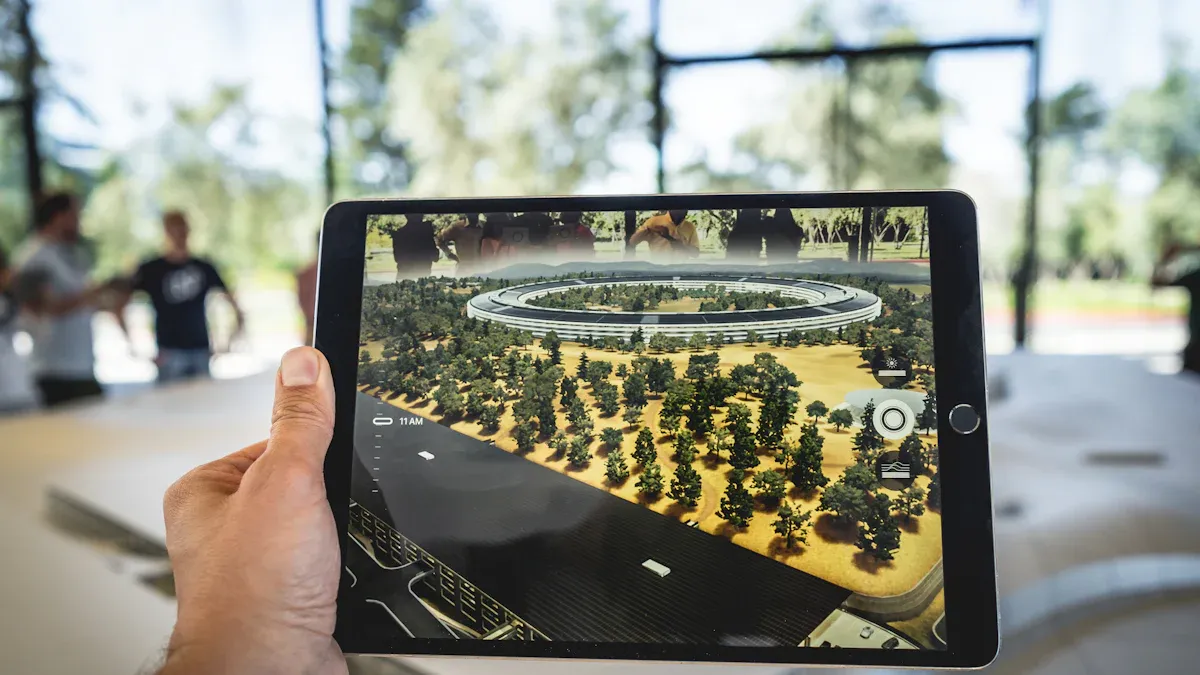
Generative AI is now a creative partner in fashion. This technology reshapes how brands define exclusivity. The generative AI in fashion market is projected to reach $1.75 billion by 2025, showing its growing impact. This shift brings three key transformations: generative AI-driven design co-creation, deep personalization with consumers, and immersive marketing stories. Brands can now build on-demand, story-rich micro-collections. This approach deepens customer loyalty for the future. The generative AI integration helps create unique fashion technology trends.
Generative AI in Design Co-Creation

Generative AI is changing the creative process in fashion. It acts as a partner for designers. This technology helps brands move from an idea to a finished product faster. The collaboration between human creativity and machine intelligence is producing exciting new results in fashion design.
From Digital Muse to Tangible Product
The design journey now often begins with a digital conversation. Designers use AI tools to create dynamic mood boards. They can input simple text prompts. For example, a designer might type "modern minimalist activewear" into an AI tool like Midjourney or DALL-E. The AI then gathers images from vast digital libraries. It organizes these visuals by color, texture, or style. This process gives designers a clear layout for a collection's theme.
Brands use these AI tools to speed up creative development. This technology helps them test many design directions quickly. The process works like this:
- An AI generates initial concepts from text, sketches, or photos.
- Design teams collaborate on the digital mood board to refine the aesthetic.
- AI can then create digital avatars to "wear" the concepts, visualizing the style before any fabric is cut.
This digital-first approach ensures the original vision carries through to the final design. It connects the initial inspiration directly to product development. This use of AI makes the early stages of fashion design more efficient and imaginative.
From Concept to Wearable Art
AI-generated designs are no longer just digital experiments. Brands are successfully turning these concepts into physical, wearable fashion. This shift proves the commercial potential of AI-designed collections. The process transforms digital inspiration into tangible art.
A great example is the Moncler x Lulu Li capsule collection. The artist used AI to explore new ideas for the fashion brand. Her experiments with AI-generated designs became the foundation for the collection. This partnership shows how a human artist can refine AI concepts into unique fashion pieces.
The collection's garments were described as being crafted ‘from bits to atoms.’ This phrase captures the perfect blend of digital inspiration and physical craftsmanship.
Other major brands are also embracing this method.
- Adidas uses AI to create unique shoe designs based on customer foot data.
- H&M applies AI to test designs and understand customer preferences for new collections.
- Tommy Hilfiger works with AI to analyze trends and inform its fashion design process.
These examples show a clear trend. AI-generated designs are becoming a key part of creating innovative and successful digital fashion. The technology helps brands produce unique AI-designed collections that connect with consumers.
Hyper-Personalization and Consumer Involvement
Generative AI is transforming the relationship between brands and shoppers. The consumer is no longer just a buyer. They are now an active participant in the fashion creation process. This shift addresses a major issue in retail. Studies show 71% of consumers feel frustrated by impersonal shopping experiences. AI-powered personalization makes fashion more engaging and relevant. It moves brands from serving broad customer groups to providing individualized attention.
Styling the Digital Self
Consumers can now curate their own style in the digital world. This creates a new level of personal connection to fashion. AI tools let users build and style a digital version of themselves. This digital self becomes a personal mannequin for trying on new looks.
Several apps are leading this change in digital fashion.
- Vybe allows users to virtually try on outfits from popular brands like Zara and H&M.
- Fits uses AI to let people try on clothes from their own digital wardrobe or a wishlist.
- Aiuta helps users build a digital closet from selfies and then swap out clothing items.
These platforms use AI to create realistic visuals and interactive fitting rooms. For example, FASHN AI technology helps brands create on-model photoshoots without a physical camera. This technology makes the design process faster and more creative. AI algorithms also provide personalized recommendations. They analyze past purchases and browsing habits to suggest items that match a consumer's unique style. The subscription service Stitch Fix uses this method well. It uses AI and data to curate clothing selections, which improves customer satisfaction. This deep fashion personalization gives the consumer more control over their digital identity and style choices.
AI-Informed On-Demand Production
Hyper-personalization connects directly to smarter manufacturing. When a consumer helps design an item, brands can produce it on demand. This AI-informed process reduces overstock and waste, a perfect solution for limited capsule collections. This approach makes the entire fashion lifecycle more efficient.
AI offers several ways to make on-demand production a reality.
- Accurate Demand Forecasting: AI analyzes trend data and consumer preferences. This helps brands predict which items will sell, so they only produce what is needed.
- Virtual Sampling: Brands can create realistic digital prototypes. This step replaces physical samples, saving fabric and resources while allowing for quick design changes.
- Optimized Material Use: AI tools can recommend the best way to cut fabric. This design method minimizes scrap material, making the production of digital-only fashion lines more sustainable.
- Pre-Order Models: Brands can show digital previews to gather pre-orders. This ensures they only manufacture what customers have already bought.
This technology allows for made-to-order and small-batch production. It aligns production with actual consumer demand. As a result, brands avoid unsold inventory and reduce their environmental impact. This smart use of AI makes the fashion industry more sustainable and responsive to what people truly want.
Immersive Marketing for Exclusive Drops

Generative AI helps brands create marketing that feels like an event. Traditional lookbooks are becoming outdated. Brands now build entire digital worlds for their capsule collections. This approach uses technology to tell a story. It makes the launch of a new fashion line an exciting experience for customers. These immersive campaigns capture attention and build a deeper connection with the audience.
Building Worlds, Not Just Lookbooks
Brands now create rich, narrative environments for their products. This method moves beyond simple photos. It uses AI to build an entire digital experience. This allows consumers to explore a collection's theme and style in a new way.
Several brands excel at this.
- Gucci builds virtual gardens and releases digital-only items on platforms like Roblox.
- Balenciaga creates video game-style shows to present its new fashion collections.
- Cartier used augmented reality to take users back to 1917, showing its watch's history through interactive storytelling.
These examples show how brands use technology to create a story around their products. The digital world becomes an extension of the brand itself.
Gamified and Interactive Rollouts
Gamification makes shopping fun. Brands are turning exclusive drops into interactive games. This strategy increases engagement and drives sales. AI helps create these personalized and playful experiences. The use of AI-generated designs within these games makes the digital items feel unique and collectible.
Many companies have found success with this model.
- Vans created 'Vans World' in Roblox, a virtual skatepark where players earn points to customize their digital outfits.
- Louis Vuitton designed a capsule collection for the game League of Legends.
- Prada featured its clothing in the racing game Riders Republic.
These interactive experiences lead to real results. Studies show that products advertised with AR or VR content have a 94% higher conversion rate. The technology lets customers "try on" items, which removes doubt and builds confidence. This immersive approach turns passive viewers into active participants.
The Future of Fashion: Strategic Outlook for 2025
The future of fashion depends on smart strategies. By 2025, brands must view generative AI as a core business partner. This technology offers actionable ways to grow. AI enables data-driven decisions that inform everything from design to marketing. It helps brands predict market trends and connect with consumers on a deeper level. The right approach will define the next generation of successful fashion.
Embrace Story-Driven Commerce
Brands should build narratives, not just sell products. Story-driven commerce creates an emotional connection with customers. AI tools analyze social media and market trends to find what stories will resonate with an audience. This data helps brands create targeted campaigns and personalized content. A strong narrative turns a simple purchase into a memorable experience. This strategy builds loyalty and makes a brand stand out in a crowded market. The future of fashion retail is about selling a feeling, and AI provides the insights to do it effectively.
Leverage Consumer Co-Creation
Brands must involve consumers in the creative process. This strategy turns shoppers into partners in fashion design. AI technology and digital platforms make this possible.
- Consumers can use AI tools to personalize items, choosing colors or materials.
- Brands can host design contests on social media, letting the community vote on new ideas.
- AR try-on features allow users to see their custom design before it is made.
This approach gives consumers a sense of ownership. It ensures the final product is something people truly want. This collaborative fashion design process strengthens the bond between a brand and its customers.
Optimize for Sustainability
Sustainability is a critical goal for the future. AI offers powerful solutions for ethical production. It helps reduce waste in two major ways. First, AI enables digital sampling. Designers can create and test realistic 3D models of clothing. This digital process replaces physical prototypes, saving fabric and reducing shipping emissions. Second, AI improves demand forecasting. It analyzes data to predict sales trends with high accuracy. This allows brands to adopt on-demand manufacturing, producing only what customers will buy. This focus on sustainability reduces overproduction and minimizes environmental impact.
The future of fashion sees AI as an essential partner for brands. AI helps brands create relevant limited-edition designs. Through co-creation, hyper-personalization, and immersive storytelling, AI improves the fashion design process. This leads to sustainable and engaging AI-designed collections. This shift redefines exclusivity in fashion.
It moves from simple scarcity to a meaningful, collaborative design experience. AI makes this new fashion design possible.
FAQ
What is generative AI in fashion?
Generative AI is a technology that creates new content. In fashion, designers use it to generate unique ideas for clothing, patterns, and styles. The AI learns from existing data to produce original designs from simple text prompts or images.
How does AI help designers create collections?
AI acts as a creative partner for designers. It helps them in several ways:
- It builds visual mood boards quickly.
- It creates digital prototypes to test looks.
- It helps visualize how a garment will fit on an avatar.
Can customers use AI to design their own clothes?
Yes, customers can participate in the design process. Many brands offer AI-powered tools. These tools let shoppers personalize items, style digital avatars, and see custom designs before they are made. This makes fashion a more interactive experience.
How does AI make fashion more sustainable? ♻️
AI promotes sustainability by reducing waste. It enables digital sampling, which replaces the need for physical prototypes. It also helps brands predict demand accurately. This allows for on-demand production, so companies only make what customers will buy.
See Also
AI's Role in Managing Rapidly Spreading Fast Fashion Trends
Innovative AI Solutions for Sustainable Fashion and a Greener Earth
Machine Learning: Predicting Fashion Trends to Significantly Boost Sales
Optimizing Brand Operations Through AI-Powered Capacity Planning Strategies
Dynamic AI Safety Stock: The 2025 Solution for Fashion Retail